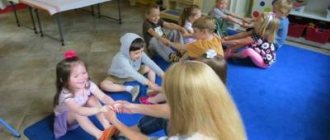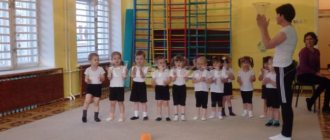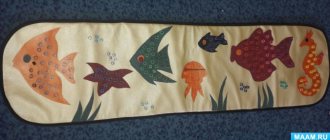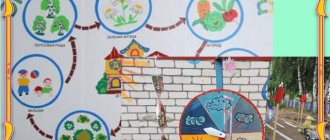Consultation for teachers
Guidelines
A hike is an organized journey or walk, a joint movement of a group of people for a specific purpose along a specific route.
Walking trips take place as part of the daily routine of preschool educational organizations. Teachers organize walks with children to the forest, park, square, as well as a green area on the territory of the kindergarten together with the parents of the pupils. Such walks are an organized type of activity, during which health-improving tasks are solved, motor skills and physical qualities of children are improved, their communicative and cognitive needs are satisfied, and interest and aesthetic attitude towards nature are cultivated.
Approximate structure of a walk-hike. The walk-trip begins with an organizational moment: all participants gather, the teacher conducts a roll call and briefing. Then the group moves to a halt, during which there may be short stops, both for rest and for observing interesting objects. The final point of the hike is a rest stop.
The resting place should be comfortable for rest. It is possible to have a picnic, set up a tent, organize games, etc. At the end of the stop, gather the children and clean the area. Then the group moves to the kindergarten; during the return there may be short stops for rest and observation.
Such walks and hikes should be carried out with pupils of senior preschool age. At this age, children are quite independent, and friendly relationships develop between peers.
Walking trips cannot be carried out frequently. The optimal number of such walks is 2-3 per year. When such events are held more frequently, they lose their attractiveness, and children’s interest in them decreases.
It is important that pupils look forward to outings, prepare for them, and prepare themselves emotionally. Therefore, we must try to ensure that after such walks children retain pleasant memories in their memory, and not negative impressions associated, for example, with fatigue from a long walk.
Algorithm for preparing a walk-hike:
— Determining the route for a walk-hike — Coordination of the route with the administration of the preschool educational institution — Careful study of the route, walking it by adults — Involving the parents of pupils to participate in the walk-hike — Selection and preparation of the necessary equipment — Preparation for briefing for the participants of the hike (determining the date, time, duration of the hike, recommendations for tourist equipment - clothing and contents of the backpack).
Preliminary work with children may include: holding conversations, organizing relay games, reading fiction and watching tourist videos. It is very important to explain to children the rules of conduct on a hike, talk about the need to obey the leader of the hike, be organized, coordinate your actions with the actions of others, follow safety rules: do not come close to the fire, do not jump in a tent, etc.
A hike may contain a surprise moment: an unexpected meeting or an interesting task. During a break and rest, it is good to play games that stimulate the cognitive and intellectual activity of children, outdoor and sports games. Students should be given the opportunity to demonstrate independence and experience for themselves all the difficulties in organizing everyday life during a hike, for example, those associated with setting up a tent.
The presence of parents, especially dads, will be valuable, communication with whom will enrich the children's experience.
Not all preschool organizations have the opportunity to go outside the kindergarten, but it is recommended to first organize a walk around the territory of the institution . This type of walk is an imitation of an adult hiking trip. It would be good if it included all the elements of a hike: gathering, a long walk, a halt, “getting together” around a fire (not necessarily a real one) and “returning” to kindergarten.
At the end of the hike, you can exchange impressions and fill out a diary. It is important that children remember the trip as an interesting journey, discovering something new, admiring the world around them, singing around the fire, playing games, communicating with each other.
Guidelines for organizing sports walks
A sports walk is a type of walk that uses a variety of elements of children’s sports-themed activities.
Sports walks can be held at least once or twice a month on those days when directly educational activities are organized that require a lot of mental stress, or directly educational activities in artistic creativity.
Depending on weather conditions, physical activity in the air can be of varying intensity so that they do not become overcooled or overheated. The teacher determines exactly how physical activity will be organized before going for a walk, focusing on specific weather conditions. During a sports walk, you should alternate tasks with high physical activity and games of low mobility, team games and subgroup, individual exercises.
Organizing a sports outing involves introducing students to various sports and athletes. An excursion or a targeted walk to a stadium (city, school, courtyard) is possible. Watching how athletes or schoolchildren are engaged will help to arouse interest in preschoolers and a desire to play sports.
A sports walk cannot be filled only with motor activities. It is recommended to select tasks of a cognitive nature and a sports orientation. For example, didactic games (“Summer and winter sports”, “Which sport is the odd one out here?”, “Recognize by silhouette”, “Who can name more types of ball sports”), attention games (“Is the starting position when throwing correct? , run"), on the imagination ("Depict a sport"). You can also include literary tasks (riddles, counting rhymes, poems).
Sports walks require preliminary work. An important stage in preparing for this type of walk is for children to gain experience in using physical education equipment: a racket, a ball, a jump rope, etc. Since during the sports walk the pupils play together with the teacher, they master skills faster.
with children of primary preschool age, you can organize a variety of outdoor games of a plot nature, including basic types of movement. You can build mock sports grounds where older students will play with younger ones, give them motor tasks, and teach them certain motor skills.
with children of senior preschool age about the history of the development of sports, introduce them to ancient and modern sports games, and tell them about the Olympics. You can introduce role-playing games “Olympics”, “Sports Clubs”, “Football Match”, in which students will be able to try on the roles of a commentator, judge, spectators, athletes, ticket sellers, etc.
Starting from the older group, team sports games adapted for preschool age should be introduced: pioneer ball, football, hockey, volleyball, tennis, etc. You can tell your students about folk games that were popular in the childhood years of their parents and grandparents, such as gorodki, hopscotch, and stander. It is advisable to devote at least half of the time of the entire sports walk to sports games.
The structure of a sports walk may include:
— Organizational moment or introductory conversation; — Outdoor, sports games; - Sport exercises; - Independent activities of children; — Individual work in various areas of development of students;
Summing up the walk, completing a creative task.
It is important to distinguish such walks from sports events - carefully prepared events for children that require them to have certain skills and abilities. Sports walks provide students with some freedom of choice (for this, several options for tasks, games, and exercises should be selected), while their interests and desires are taken into account. Outings are not as strictly structured as sports events and entertainment.
Approximate scenarios for walks, hikes and sports walks are presented in the magazine “Handbook of a senior teacher of a preschool institution” No. 10 / October 2013,
No. 11/ November 2013.
Literature:
— “Methodological recommendations for organizing walks and hikes”, K.Yu. Belaya, E.A. Karalashvili, L.I. Pavlova // “Handbook of a senior teacher of a preschool institution” No. 10 / October 2013, p. 10 - “Methodological recommendations for organizing sports outings”, K.Yu. Belaya, E.A. Karalashvili, L.I. Pavlova// “Handbook of senior preschool teachers” No. 11/ November 2013, p.4





